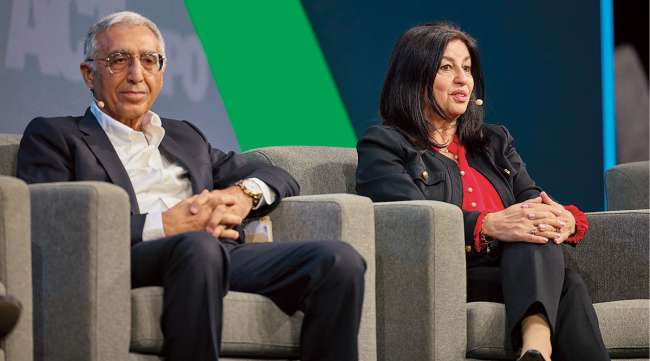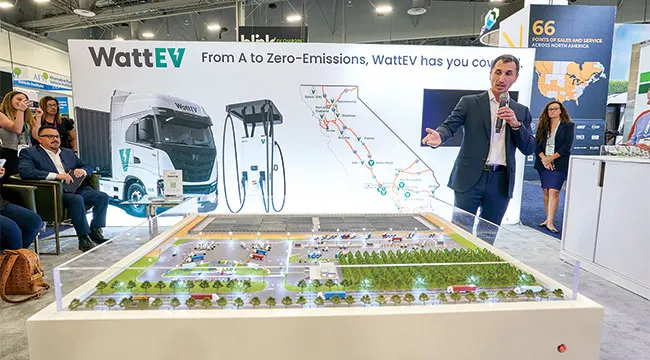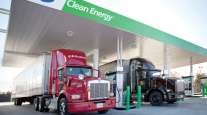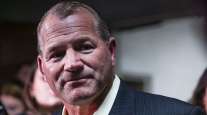Trucking’s Clean Power Transition Hinges on Infrastructure

[Stay on top of transportation news: Get TTNews in your inbox.]
LAS VEGAS — Wider adoption of low- and zero-emission commercial trucks will depend on the development of new fueling and charging infrastructure, but industry stakeholders will need to overcome a variety of challenges along the way.
Energy sector leaders highlighted the importance of government incentives, consistent energy policies and industry partnerships to ease the transition toward cleaner trucks and the infrastructure to support them.
“We are trying to skate where the puck is,” said Andy Walz, president of Americas products at Chevron. “We do believe this is coming, but it is a big challenge today to get people to want to pay more for products.”
Walz was one of several speakers who discussed fueling and charging infrastructure needs for commercial vehicles at the 2024 Advanced Clean Transportation Expo, held May 20-23.

Walz
Selda Gunsel, chief technology officer and executive vice president technology for Shell Group, said fuel providers are expected to create more energy while reducing emissions, which makes the challenge even greater.
“We also know there is not one solution that can enable energy transition, so we have to work on multiple solutions,” she said.
In addition to the rollout of battery-electric trucks, fleet operators and industry stakeholders are exploring — and investing in — alternatives, such as biofuels, renewable diesel, renewable natural gas, hydrogen fuel cell trucks and hydrogen combustion engines.
Chevron’s Walz expressed concerns over regulatory requirements in some areas, including California, that essentially are moving toward a one-strategy approach — electrification.
“Make sure you’re not limiting options. Put all options on the table,” he said, adding that energy needs to be affordable and reliable while also getting cleaner.
Chanel Parson, director of clean energy and demand response for Southern California Edison, said it will take “unprecedented electrification for California to reach carbon neutrality by 2045,” and the electrical grid needs to be updated at a rapid pace to meet EV charging demands. However, grid-related projects can take years to complete.
If we don't start now, we will be too late to meet the demand that arises.
Chanel Parson, director of clean energy and demand response for Southern California Edison
Image
SCE, an electric utility in California, is advocating for the streamlining and expediting of permitting for grid construction projects and is proactively upgrading the grid in key areas, such as ports and freight corridors.
RELATED: Greenlane Eyes Securing 20 Sites by End of 2025, CEO Says
“If we don’t start now, we will be too late to meet the demand that arises,” Parson said.
Shell’s Gunsel voiced similar concerns about the buildout of EV charging infrastructure.
“We are told at one location it can take 12 to 24 months for the utilities to get the energy we need,” Gunsel said. “These are really barriers that hurt us in terms of encouraging EV adoption.”
Microgrids, which are local electrical grids built on-site, are one tool that charging providers can use to help meet demand.
WattEV, which has opened four operational charging sites, created a microgrid at its location in Bakersfield, Calif. The project cost more than $25 million.
“Part of it was to demonstrate it is possible to reduce the cost of energy,” said Emil Youssefzadeh, chief technology officer and co-founder of WattEV. “It is a significant investment, but long term we think it could reduce the cost to get the energy.”

Salim Youssefzadeh, CEO of electric truck-as-a-service provider WattEV, outlines the company’s expansion plans during a news conference at ACT Expo 2024. (ACT Expo)
TravelCenters of America is installing a microgrid at its location in Ontario, Calif., which is the company’s busiest site, said Dean Bushey, TA’s senior vice president of sustainability.
Having a microgrid will help with “demand shaving” to ensure the company can meet power needs without facing higher surge pricing from the utility if trucks plug in and draw a lot of power quickly.
There are tens of thousands of different pricing models for electricity across the U.S. grid, which can alter the economics of charging sites, said John DeBoer, head of eMobility solutions in North America for Siemens.

DeBoer
“We’re seeing price spreads are growing dramatically,” he added.
Incentives, including several in the Inflation Reduction Act of 2022 and Infrastructure Investment and Jobs Act of 2021, can help fund microgrids.
Tax incentives and grants play a critical role in attracting capital to low-carbon options, speakers said.
“Globally it is going to take a tremendous amount of money and subsidies to turn the equation and make a real difference,” Chevron’s Walz said.
SCE distributes incentives and looks at where the market needs acceleration. Recently, it has started to transition from incentivizing light-duty vehicles to medium- and heavy-duty vehicles.
“There are a lot of people who don’t have the capital to purchase the vehicles or have the space or capital to install infrastructure,” Parson said.
RELATED: Perspective: EPA’s GHG Phase 3 Rule Needs Fixing
Corey Cox of the Tandet Group of companies discusses how early AI adopters are beginning to harvest the latest wave. Tune in above or by going to RoadSigns.ttnews.com.
Many low- and zero-emission solutions cost more than their diesel equivalent, and there aren’t a lot of customers willing to pay more today, Walz said.
“That is a watch point,” he said.
The economics are expected to change, however, as adoption increases.
“Once we get enough infrastructure in the ground and enough up-front capital out there, the vehicles and transformation will pay for itself,” SCE’s Parson said.
It will take utilities, policymakers, regulators, private companies and equipment manufacturers working together to roll out new fueling infrastructure, so partnerships among those various stakeholders are taking on increased importance.
Gunsel said Shell has partnered with BYD in China on EVs and Cummins on natural gas engines. In Europe, the company is a founding partner of the H2Accelerate foundation, which is working to enable hydrogen fueling for commercial road transport. Shell also has introduced its Starship 3.0 concept truck to highlight opportunities to improve fuel efficiency through multiple technologies.
While hydrogen and electrification are long-term energy solutions, biofuels, renewable diesel and renewable natural gas can help reduce emissions today and in the coming years, and Gunsel said Shell is focusing on all available solutions.
Want more news? Listen to today's daily briefing above or go here for more info
“In the biofuels space, we have made a lot of investments in second-generation biofuels that do not compete with food sources,” she said.
Chevron acquired Renewable Energy Group, a biofuels producer, in 2022 for $3.15 billion and has plans to grow its biodiesel production.
“We’re also believers in renewable natural gas and compressed natural gas,” Walz added.
However, government policies are not favorable for biodiesel and renewable diesel.
“It is hurting us and not helping us with where we want to go,” he said, adding that strong and consistent energy policies are needed to enable the energy transition.
Policy is the “single biggest risk factor” Walz thinks about when making a decision.
“I don’t care what the policy is today, but I need it to be really resilient,” he said, adding that policies for two-, four- or six-year cycles aren’t enough.
Despite the difficulties, Walz believes motivated parties will push ahead to meet fleets’ needs.






